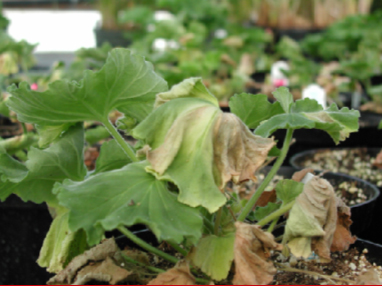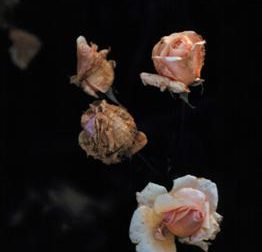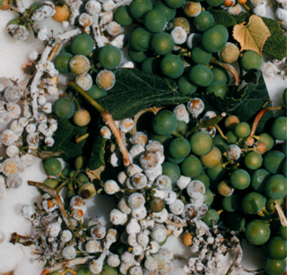What is Ralstonia wilt?
Ralstonia wilt (also sometimes known as Southern wilt) is a typically lethal disease that affects over 250 plants in over 40 plant families. Susceptible greenhouse-grown ornamentals include, but are not limited to, plants in the genera Capsicum, Cosmos, Cyclamen, Dahlia, Fuschsia, Gerbera, Hydrangea, Impatiens, Lantana, Nasturtium and Pelargonium. Vegetables such as eggplant, pepper, potato and tomato, as well as tobacco, are also susceptible. Ralstonia wilt was first reported on geraniums (Pelargonium spp.) in Wisconsin in 1999. In 2020, the disease was reported on Fantasia® ‘Pink Flare’ geraniums in Michigan. Potentially infected ‘Pink Flare’ geraniums were also distributed to 38 other states including Wisconsin.

What does Ralstonia wilt look like?
Symptoms of Ralstonia wilt in geraniums are similar to those associated with bacterial blight (caused by Xanthomonas campestris pv. pelargonii). Initially, lower leaves of infected plants yellow and wilt, then die. Yellowing and death of upper leaves follow. Symptoms may initially occur on only one side of the plant. Internally, the water-conducting tissue of the plant browns, and then the entire stem rots from the inside out. Eventually, infected plants die.
Where does Ralstonia wilt come from?
Ralstonia wilt is caused by the bacterium Ralstonia solanacearum (formerly Pseudomonas solanacearum). This bacterium is commonly found in tropical, sub-tropical and warm temperate climates, but it is not believed to survive cold temperatures such as those typical of Wisconsin winters. The bacterium can be moved in symptomless plants or cuttings, or in contaminated soil and plant debris (where the pathogen can remain dormant for many years). Several subgroups (i.e., races and biovars) of R. solanacearum have been recognized, each with a different host range. R. solanacearum race 3, biovar 2 is of particular concern because it causes a serious disease of potato called brown rot. In addition, this race/biovar has been listed as a select agent by the U.S. government and is considered to have potential to be developed as a bioterrorist weapon against U.S. agriculture.
How do I save plants with Ralstonia wilt?
There are no known treatments that will save plants affected by Ralstonia wilt. If you believe your plants are suffering from this disease, immediately contact your local department of agriculture or county Extension agriculture or horticulture agent to arrange for confirmatory testing. If you live in Wisconsin, you can contact the UW-Madison Plant Disease Diagnostics Clinic (see below for contact information) for assistance. If your plants test positive for R. solanacearum race 3, biovar 2 the United States Department of Agriculture Animal and Plant Health Inspection Service (USDA APHIS) must be notified and this organization will provide guidance on proper disposal of contaminated plants, as well as decontamination of greenhouses or other sites where contaminated plants have been grown.
How do I avoid problems with Ralstonia wilt in the future?
Start by purchasing and growing pathogen-free plant cuttings. Keep plants from different suppliers physically separated by at least four feet to minimize the risk of cross contamination should a shipment of plants prove to be contaminated. Because R. solanacearum is easily moved with soil or water, minimize splashing or any other movement of water or soil from plant to plant when watering. When taking cuttings or trimming plants, be sure to clean cutting tools between cuts using an approved disinfectant. For a complete list of such products, contact the UW-Madison Plant Disease Diagnostics Clinic (see below for contact information). Also wear disposable gloves (nitrile are best) when handling plants, and change gloves between working with different geranium varieties. This will minimize the possibility of moving R. solanacearum by touch. If gloves are not available, wash your hands frequently and thoroughly (especially between geranium varieties) with lots of soap and water or with an alcohol-based hand sanitizer. Remove and destroy weeds or weed debris as these can harbor the pathogen. Finally, do not grow plants in a greenhouse where the disease has occurred unless it has been properly decontaminated.
For more information on Ralstonia wilt:
Contact the University of Wisconsin Plant Disease Diagnostics Clinic (PDDC) at (608) 262-2863 or pddc@wisc.edu.
Authors: Brian Hudelson, UW-Madison Plant Pathology
Last Revised: 03/01/2024
D-number: D0090
References to pesticide products in this publication are for your convenience and are not an endorsement or criticism of one product over similar products. You are responsible for using pesticides according to the manufacturer’s current label directions. Follow directions exactly to protect the environment and people from pesticide exposure. Failure to do so violates the law.
Thanks to Alemu Mengistu, Julie Tans-Kersten and Laurie Weiss for reviewing this document.
A complete inventory of UW Plant Disease Facts is available at the University of Wisconsin-Madison Plant Disease Diagnostics Clinic website: https://pddc.wisc.edu.
Send a Plant Sample for Analysis
Be cautious when self-diagnosing plant health issues. Very few diseases can accurately be diagnosed by eye.
Contact the UW Plant Disease Diagnostics Clinic (PDDC), and for a small fee, clinic staff can examine a plant, determine the cause of the disease/disorder, and provide advice on how to control or prevent the issue.
Download Article





 Fire Blight
Fire Blight Gray Mold (Botrytis Blight)
Gray Mold (Botrytis Blight) Late Blight
Late Blight Downy Mildew
Downy Mildew


